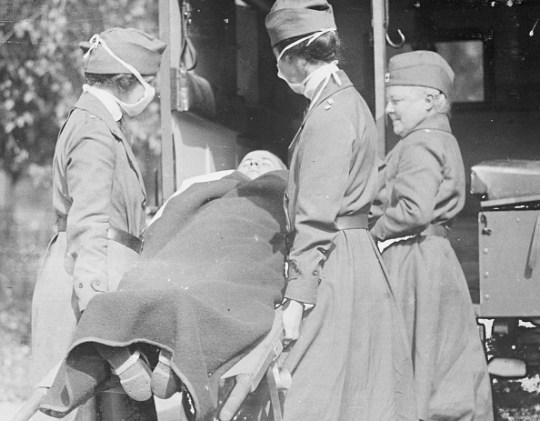
A hundred years ago, people all over the world were falling asleep uncontrollably.
Not because of a hard day’s work or a late night, but because of a condition known as “sleeping sickness.”
Victims fell into such a deep sleep that those afflicted often did not wake up for weeks or even months. The disease was also fatal, killing 30 to 40 percent of those afflicted, usually from respiratory failure.
An epidemic, it appeared in northern France in 1916, spreading first across Europe, then to North America, Central America and India, before almost entirely disappearing by 1930.
To this day, no one knows exactly how the disease spread, what caused it, or whether it might return.
Called encephalitis lethargica (EL), it first causes flu-like symptoms, including headache, nausea, joint pain, and fever. From there, it spreads to the eyes, which become uncoordinated, leading to double vision. The eyelids then begin to droop, and patients feel the need to sleep, both day and night.
Although they could often be awakened, patients quickly fell back asleep, often experiencing vivid dreams or nightmares. Some, however, were in a coma.
In a magazine article discovered by Scientific American, Eleanore Carey, a young woman living in New York, describes the disease as “being buried in a pit as deep as the center of the Earth.”
“After two months of illness, I felt little pain, in fact, I was very comfortable, as long as they didn’t push me, put me on my head, turn me over in bed and throw cold water on my face to wake me up,” she said.
“It was so heavenly to be able to sleep, but these people around me seemed determined to prevent me from being comfortable! When the idea finally crept into my sleeping brain that I had to wake up, it seemed a physical impossibility. I wanted to oblige, but I simply couldn’t.

“It seemed as difficult to regain consciousness as if I had been buried in a pit as deep as the center of the earth, where the circular walls around me were of shiny, polished marble.”
Another girl was not so lucky. As she was walking home from a concert, one side of her body suddenly became paralyzed and she fell into a deep sleep. She died 12 days later.
Follow Metro on WhatsApp to be the first to receive all the latest news

Metro is on Whatsapp! Join our community for breaking news and juicy stories.
At the Derby and Derbyshire Rescue and Training Centre (for girls), 12 of the 21 girls and women in the home fell victim to EL in a fortnight. Half of them died within 10 days of developing symptoms.

This case is an example of the disease being contagious, but many others have no connection with this phenomenon.
Of 1,156 cases in Vienna, 520 in Germany and 464 in France, no evidence of direct transmission was found – but natural immunity to the disease could not be ruled out, allowing “healthy” people to spread the disease without realising it.
The number of patients believed to have been affected by EL ranges from 52,000 to one million, but despite this high number, doctors were unable to determine the cause of their endless sleep.
By the 1920s, more than 2,000 scientific papers had been written about the disease, but no one had found a definitive answer.
Its emergence around the same time as the Spanish flu pandemic led some to suggest it could be linked to the H1N1 virus that killed up to 50 million people worldwide.
But analyses carried out then and more recently, using well-preserved brain samples, have shown no evidence of the existence of a bacteria or virus capable of triggering such a reaction.

Others think it may be an autoimmune response, an overreaction of the body triggered by a cold or flu virus, rather than a result of the infection itself.
A reasonable explanation, but one that fails to explain how this phenomenon could appear and disappear so quickly, sweeping across entire countries before evaporating.
Unfortunately, even though the disease itself has stopped spreading, the lives of those infected have not returned to normal.
Many developed Parkinson’s disease, with symptoms ranging from tremors to complete loss of the ability to move their muscles, becoming “paralyzed.”
Known as post-encephalitic Parkinson’s syndrome (PEP), it can also cause changes in character and behavior in younger patients, ranging from clinginess and difficulty concentrating in youth to violence in adolescence.
As adults, those whose PEP did not land them in hospital often found themselves living lives of crime, including committing violent acts such as rape and murder.
Many call it “the disease that creates criminals.”
Some scientists believe Hitler may have had PEP, suspecting he suffered from EL while in hospital recovering from exposure to poison gas at the age of 29.

Autopsies and scans of people with EL and PEP have revealed damage in a particular region of the brain, the basal ganglia, which – among other functions – controls movement and emotional processing.
With few cases of EL since then, there has been little opportunity to study the disease or determine whether it might ever recur.
In 2001, a case of a woman who died after 12 months of EL was published, and again revealed brain swelling, but no virus or other obvious cause.
Today, a century after the outbreak, scientists are no closer to solving the mystery of sleepiness disease – a disease far more dangerous than it seems.
MORE: ‘Excalibur’ sword stuck in rock for 1,300 years mysteriously disappears
MORE: Man stung by bee in horrific location – but not where you think
MORE: Weirdest excuse for poor exam results revealed
Get breaking news, heartwarming stories, analysis and more
This site is protected by reCAPTCHA and the Google Privacy Policy and Terms of Service apply.